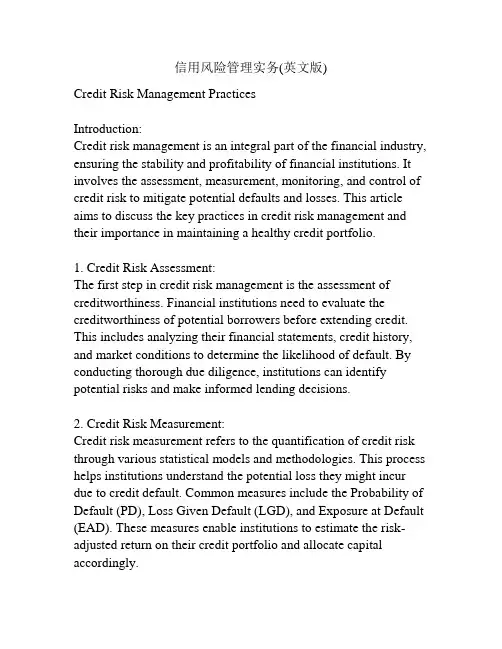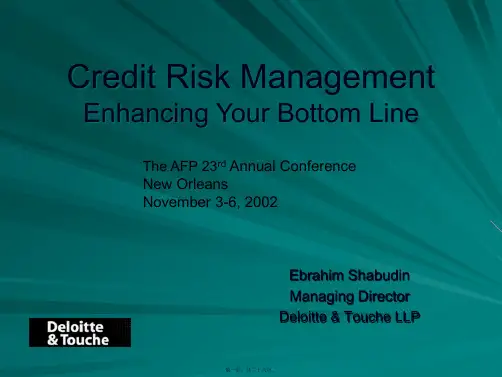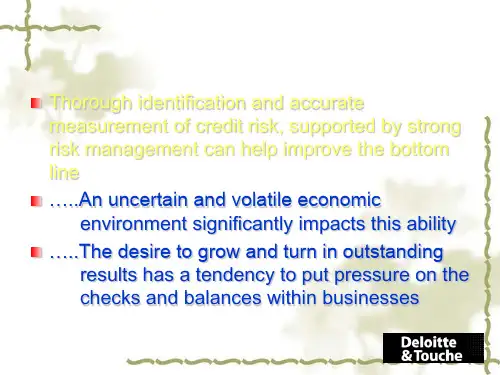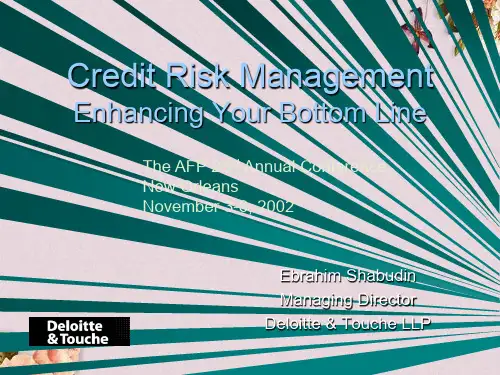信用风险管理(英文)
- 格式:ppt
- 大小:222.00 KB
- 文档页数:35


信用风险管理实务(英文版)Credit Risk Management PracticesIntroduction:Credit risk management is an integral part of the financial industry, ensuring the stability and profitability of financial institutions. It involves the assessment, measurement, monitoring, and control of credit risk to mitigate potential defaults and losses. This article aims to discuss the key practices in credit risk management and their importance in maintaining a healthy credit portfolio.1. Credit Risk Assessment:The first step in credit risk management is the assessment of creditworthiness. Financial institutions need to evaluate the creditworthiness of potential borrowers before extending credit. This includes analyzing their financial statements, credit history, and market conditions to determine the likelihood of default. By conducting thorough due diligence, institutions can identify potential risks and make informed lending decisions.2. Credit Risk Measurement:Credit risk measurement refers to the quantification of credit risk through various statistical models and methodologies. This process helps institutions understand the potential loss they might incur due to credit default. Common measures include the Probability of Default (PD), Loss Given Default (LGD), and Exposure at Default (EAD). These measures enable institutions to estimate the risk-adjusted return on their credit portfolio and allocate capital accordingly.3. Credit Risk Monitoring:After extending credit, it is essential to continuously monitor the creditworthiness of borrowers. Regular monitoring allows institutions to identify early warning signs of potential default, enabling them to take timely actions to minimize losses. Key monitoring activities include reviewing financial statements, credit reports, market conditions, and conducting site visits or customer interviews when necessary.4. Credit Risk Control:Credit risk control involves implementing strategies and measures to mitigate credit risk. This includes setting appropriate credit limits, establishing credit policies and procedures, and utilizing collateral or guarantees to secure loans. Institutions should also establish an effective credit risk review process, ensuring that credit exposure is within acceptable limits and periodically reassessed.5. Credit Risk Diversification:Diversification is crucial in credit risk management to reduce concentration risk. Institutions should strive to have a well-diversified credit portfolio, spreading their exposure across various industries, geographies, and borrower types. This helps mitigate the impact of potential defaults in specific sectors or regions and reduces the overall risk of the portfolio.6. Credit Risk Mitigation:In addition to diversification, various credit risk mitigation techniques can be employed. These include credit default swaps, loan syndications, securitization, and credit insurance, amongothers. These risk mitigation tools help transfer or share credit risk with other parties, reducing an institution's exposure to potential defaults.7. Stress Testing:Stress testing is an important practice in credit risk management that evaluates the resilience of a credit portfolio under adverse scenarios. Institutions simulate a range of stress scenarios, such as economic downturns or industry-specific shocks, to assess the potential impact on credit portfolios. This helps institutions identify vulnerabilities, evaluate the adequacy of capital reserves, and develop contingency plans.Conclusion:Effective credit risk management is critical for the financial stability and profitability of institutions. By employing robust credit risk assessment, measurement, monitoring, and control practices, institutions can reduce the likelihood and impact of defaults, resulting in a healthier credit portfolio. Additionally, diversifying credit exposure and utilizing risk mitigation techniques further enhance the resilience of institutions against credit risk. Regular stress testing ensures that institutions are prepared for unexpected adverse scenarios. Overall, a comprehensive credit risk management framework helps institutions make informed lending decisions and protect themselves from potential losses.Sure! Here is the continuation of the article:8. Credit Risk Reporting:An essential component of credit risk management is regular andcomprehensive reporting. Institutions should establish a robust reporting framework to monitor and communicate credit risk exposures and trends to relevant stakeholders, including senior management, regulatory authorities, and investors. This helps facilitate informed decision-making, risk assessment, and strategic planning.9. Credit Risk Culture:A strong credit risk culture within an institution is crucial for effective risk management. It involves instilling a risk-aware mindset and promoting accountability at all levels of the organization. Employees should be educated on credit risk principles, policies, and procedures to ensure consistent adherence to risk management practices. Additionally, establishing a reward system that aligns with prudent credit risk management encourages employees to make sound credit decisions.10. Regulatory Compliance:Credit risk management practices must comply with applicable regulatory requirements. Financial institutions are subject to regulations and guidelines issued by regulatory authorities, such as the Basel Committee on Banking Supervision. Compliance with these regulations ensures that institutions maintain adequate capital levels, risk management frameworks, and disclosure requirements. Failing to comply with regulatory standards can lead to penalties, reputational damage, and legal consequences.11. Technology and Analytics:Technological advancements and data analytics play a pivotal role in credit risk management. Institutions should leverage innovativetools and systems to automate and streamline credit risk processes, improve data accuracy, enhance risk modeling capabilities, and enable real-time monitoring. Predictive analytics can help identify early warning signals of potential credit deteriorations and facilitate proactive risk management actions.12. Scenario Analysis:Apart from stress testing, institutions can benefit from conducting scenario analysis to assess the impact of specific events or market changes on their credit portfolios. This involves simulating different scenarios, such as changes in interest rates, commodity prices, or currency fluctuations, to evaluate the sensitivity of the portfolio and identify potential risks. By assessing various scenarios, institutions can better prepare for potential credit risks and adapt their risk management strategies accordingly.13. Portfolio Review and Remediation:Regular portfolio reviews are essential to identify underperforming loans and take appropriate remedial actions. Institutions should periodically assess their credit portfolios, identifying loans with high credit risk or potential defaults. Actions may include restructuring loans, providing additional support to borrowers, or even selling off non-performing assets. This proactive approach helps minimize losses and improve the overall quality of the credit portfolio.14. Risk Appetite Framework:Establishing a risk appetite framework is crucial in credit risk management. This framework sets the boundaries within which the institution is willing to accept credit risk. It defines the tolerancelevel for credit risk exposure and guides strategic decision-making. The risk appetite framework should align with the institution's overall risk profile, business strategy, and financial goals, ensuringa consistent and well-defined approach to credit risk management.15. Talent and Expertise:Having a competent and experienced credit risk management team is vital for effective risk management. Institutions should invest in hiring and retaining skilled professionals with expertise in credit analysis, risk modeling, financial markets, and regulatory compliance. Additionally, providing ongoing training and professional development opportunities helps keep the team updated with the latest industry trends and best practices in credit risk management.Conclusion:In conclusion, effective credit risk management practices are essential for financial institutions to mitigate the potential defaults and losses associated with lending activities. Credit risk assessment, measurement, monitoring, and control form the foundation of a comprehensive risk management framework. Diversification, risk mitigation techniques, and stress testing further enhance risk resilience. Strong credit risk culture, regulatory compliance, technology utilization, scenario analysis, and portfolio reviews contribute to a robust credit risk management framework. Ultimately, successful credit risk management enables institutions to make informed lending decisions, protect themselves from potential losses, and ensure the stability and profitability of their credit portfolios.。




